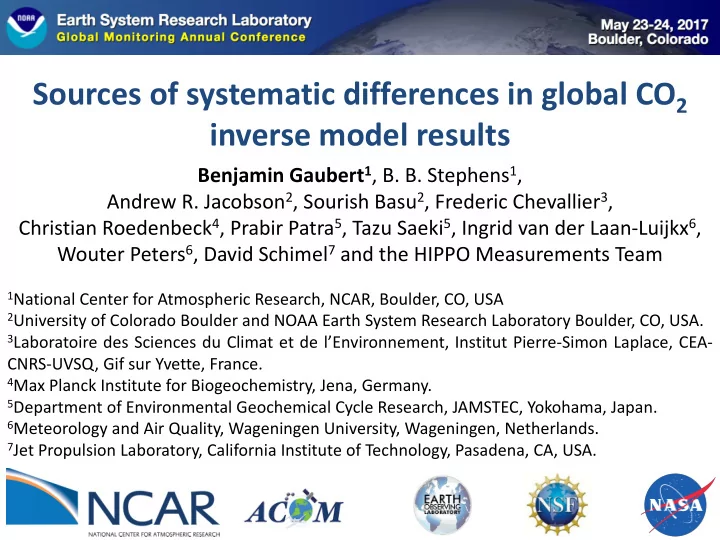

Sources of systematic differences in global CO 2 inverse model results Benjamin Gaubert 1 , B. B. Stephens 1 , Andrew R. Jacobson 2 , Sourish Basu 2 , Frederic Chevallier 3 , Christian Roedenbeck 4 , Prabir Patra 5 , Tazu Saeki 5 , Ingrid van der Laan-Luijkx 6 , Wouter Peters 6 , David Schimel 7 and the HIPPO Measurements Team 1 National Center for Atmospheric Research, NCAR, Boulder, CO, USA 2 University of Colorado Boulder and NOAA Earth System Research Laboratory Boulder, CO, USA. 3 Laboratoire des Sciences du Climat et de l’Environnement, Institut Pierre-Simon Laplace, CEA- CNRS-UVSQ, Gif sur Yvette, France. 4 Max Planck Institute for Biogeochemistry, Jena, Germany. 5 Department of Environmental Geochemical Cycle Research, JAMSTEC, Yokohama, Japan. 6 Meteorology and Air Quality, Wageningen University, Wageningen, Netherlands. 7 Jet Propulsion Laboratory, California Institute of Technology, Pasadena, CA, USA.
Understanding the global CO 2 budget : Global Carbon Project Le Quéré et al. [2016] AGR = FF + OCEAN + LAND 1. The atmospheric growth rate is well known (derived from observations) 2. Fossil Fuel total emissions are well known 3. Global land = Residual Perturbation of the global carbon cycle caused by anthropogenic activities, averaged globally for the decade 2006–2015 (GtCO 2 /yr) Source: CDIAC; NOAA-ESRL; Le Quéré et al 2016; Global Carbon Budget 2016
Derive CO 2 fluxes knowing priors and observations Ø In-situ surface and aircraft observations Ø Satellite retrievals Ø Atmospheric Transport Model (H) Ø CO2 = H(x) + r Ø Prior fluxes (x) Optimized fluxes (∆) $%&' +(∆) )*+%& + 𝑇 ..
Ø Are inverse models still highly dependent on transport errors and a priori assumptions ? 1.Comparison of modelled a posteriori fluxes and Global Carbon Project 2.CO 2 modelled after flux optimisation is compared to HIPPO observations Grid Transport Meteorological Modelling system References Spacing Model fields MACC-II Chevallier et al. 3.75° x 1.875° LMDZ ECMWF wind (v14r2) (JGR 2010; GMD 2013) Jena Rödenbeck (2005) 4° x 5° TM3 ERA interim (S04_v3.8) CTE2016 van der Laan-Luijkx et al. (2017) 1° x 1° TM5 ERA interim Peters et al. (2007) CT2016 with updates documented at 1° x 1° TM5 ERA interim http://carbontracker.noaa.gov ACTM T106 Saeki and Patra (2017) ACTM NCEP2 IEA & CDIAC (0.88 x0.84) TM5-4DVar Basu et al. (2013) 3° x 2° TM5 ERA interim
Model results were systematically dependent on atmospheric transport Northern Land Tropical Land
All units are PgC/yr Northern extra-tropical flux Trop + Southern Land flux T3L2 (Gurney et al. 2004) -2.42 +/- 1.09 0.95 +/- 1.22 T3L2 subset -1.52 +/- 0.64 -0.49 +/- 0.3 (Stephens et al. 2007) RECCAP (Peylin et al. 2013) -2.25 +/- 0.58 0.93 +/- 0.9 This work -2.18 +/- 0.52 -0.62 +/- 0.67
All units are PgC/yr Northern extra-tropical flux Trop + Southern Land flux T3L2 (Gurney et al. 2004) -2.42 +/- 1.09 0.95 +/- 1.22 T3L2 subset -1.52 +/- 0.64 -0.49 +/- 0.3 (Stephens et al. 2007) RECCAP (Peylin et al. 2013) -2.25 +/- 0.58 0.93 +/- 0.9 This work -2.18 +/- 0.52 -0.62 +/- 0.67 Ø Is the remaining spread still due to transport error ?
Evaluation of posterior CO 2 concentration vs. HIPPO data Provide large scale CO 2 measurements with coverage Ø in latitude, time, and vertical gradients Filter out continental BL, Airport, Ø stratospheric air Detrended time series using Mauna-Loa trend Ø component
Ø Fit of the time series for each box (5 degrees latitude and 100 hPa), using 2 harmonics Ø Focus on vertical gradients v Northern Extratropical Lower Troposphere (LT, surface 700hPa) and Upper Troposphere (UT, 700hPa to 300hPa) Ø Weighting average using cos(latitude) Ø Repeat for every model output using CO2.X mask UT UT LT LT
CO 2 modelled after flux optimisation is compared to HIPPO observations NE Land flux versus NE vertical gradients
CO 2 modelled after flux optimisation is compared to HIPPO observations NE Land flux versus NE vertical gradients Stephens et al. 2007
CO 2 modelled after flux optimisation is compared to HIPPO observations NE Land flux versus NE vertical gradients
CO 2 modelled after flux optimisation is compared to HIPPO observations NE Land flux versus NE vertical gradients Ø Large improvements in representing CO 2 vertical gradients Ø Retrieved fluxes do not show vertical error dependence
Posterior fluxes and Global Carbon Project
Posterior fluxes and Global Carbon Project
Posterior fluxes and Global Carbon Project
Conclusions Ø Analysis of carbon fluxes estimated by a set of inverse models show good consistency, but spread remains in the spatial attribution of land sinks Ø The transport errors are not clearly responsible for those fluxes differences Ø Error in prior Fossil Fuel emissions is compensated by changes in other estimates such as AGR, or land sink [Saeki and Patra 2017] Ø The spread in prior FF emissions is larger than GCP error and of similar magnitude to results spread Ø As previously shown [Peylin et al., 2013], the results are sensitive to atmospheric network, so satellite observations from OCO2 may help
Thanks for your attention
Posterior fluxes and Global Carbon Project
Recommend
More recommend